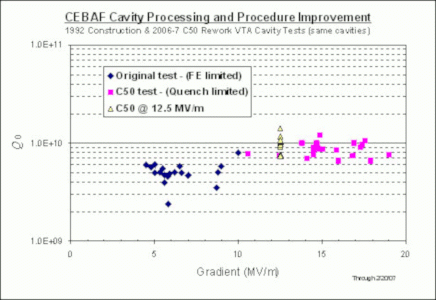Cavity Processing and Procedure Improvements

Additional Links
Jefferson Lab continues to integrate the fruit of superconducting radiofrequency (SRF) R&D into the production of higher-performing accelerator components. One dimension of this is a program to leverage recent technological developments in the design and implementation of higher quality standards and more efficient techniques for the chemical processing, clean handling and assembly of accelerator components.
To secure the 6 GeV base of the Lab’s Continuous Electron Beam Accelerator Facility (CEBAF), a program (C50) is underway to rework weaker accelerator components. CEBAF originally contained 42 sections of accelerator components, called cryomodules. Each full cryomodule contains a string of eight niobium accelerator cavities. In this program, a cryomodule is removed from CEBAF, fully disassembled, the cavities reprocessed, and the full unit reassembled, tested, and returned to service.
The specification for cavities in the C50 cryomodules in CEBAF is 12.5 MV/m, creating a 50 MV cryomodule from hardware originally designed to produce 20 MV. This success is made possible by applying state-of-the-art procedures and techniques developed in the years since CEBAF was originally built.
Capital improvements made possible by work-for-other projects such as the construction of cryomodules for the Spallation Neutron Source (SNS) and an enhanced level of rigor and specificity in the assembly procedures have yielded a dramatic improvement in particulate contamination control. This new, automated equipment made possible clean acid etching of cavities and rinsing them with high-pressure, ultrapure water. The contamination responsible for the performance-limiting field emission phenomenon was thus eliminated.
Before this program, field-emission loading interior to the cavities was the principle performance-limiting phenomenon, causing an excessive heat load for the cryogenic system and also rf window arc-trips that interrupt beam delivery. The cavities are now limited by quenching attributed to original 1991 material or fabrication defects. The data for the early production cavities from the C50 effort are presented in the figure, together with the field-emission-limited performance from 1992 for the same cavities.
This evolution of the technology provides a foundation for the successful implementation of the 12 GeV upgrade and all other high-performance SRF accelerator applications.

